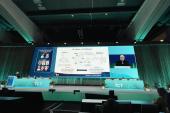REC-CAGEFREE I: DCB Fails to Match Up to DES for De Novo CAD
The trial was set up to give DCBs their “best shot” in this patient group, says one researcher, but it’s tough to beat current DES.

LONDON, England—A paclitaxel-coated balloon did not perform as well as a drug-eluting stent when it came to treating a broad group of patients with de novo, noncomplex coronary lesions, results of the REC-CAGEFREE I trial show.
The rate of a device-oriented composite endpoint (DOCE)—incorporating cardiac death, target-vessel MI, and clinically and physiologically indicated TLR—through 2 years was 6.4% with the drug-coated balloon (DCB) and 3.4% with the DES, a difference that failed to establish the noninferiority of the balloon (P = 0.65). It was, in fact, significantly worse than the stent (P = 0.0008).
Ling Tao, MD, PhD (Xijing Hospital, Fourth Military Medical University, Xi’an, China), reported the data last week at the European Society of Cardiology Congress 2024. The findings were published simultaneously online in the Lancet.
Although prior nonrandomized studies and smaller RCTs using surrogate endpoints suggested DCBs would perform well for de novo coronary disease, this study, which is the first RCT pitting a DCB against a DES in this population irrespective of vessel diameter, showed an increased rate of TLR with the balloon. Tao said the overall DOCE rate with DES observed here is difficult to improve upon.
“DES implantation should remain . . . the preferred treatment strategy for these patients at present, especially for those with non-small vessel disease,” she concluded during her presentation.
Tao noted that follow-up will continue through 10 years, which will allow investigators to see whether the higher rate of revascularization observed in the DCB arm will translate into mortality and MI or if DCB treatment will prevent late events.
The REC-CAGEFREE I Trial
DCBs have been explored as a way to avoid potential issues that arise from leaving metal in the coronary arteries. They now have a class IA recommendation for the treatment of in-stent restenosis in the European revascularization guidelines. In the United States, the first coronary DCB—Agent (Boston Scientific)—gained approval for the treatment of in-stent restenosis from the US Food and Drug Administration earlier this year on the strength of the AGENT IDE trial.
There is some evidence that DCBs may be useful for patients with de novo small-vessel disease (SVD) as well. The BASKET-SMALL 2 trial, for instance, showed that a DCB was noninferior to a second-generation DES in terms of 1-year MACE in this population.
Use of DCBs in de novo non-SVD, however, remains controversial, Tao said.
REC-CAGEFREE I, conducted at 43 sites in China, helps address that question. Investigators recruited 2,902 patients undergoing PCI for de novo, noncomplex coronary disease, ultimately randomizing 2,272 (median age 62 years; 69.3% men) who underwent successful predilatation to treatment with a paclitaxel-coated balloon (Swide DCB; Shenqi), with rescue stenting allowed, or a sirolimus-eluting stent (Firebird2; MicroPort).
There were no limits on vessel diameter, and about half of patients had SVD (< 3.0 mm).
About 16% of the participants presented with STEMI, 18% with NSTEMI, 20% with unstable angina, and 45% with chronic coronary syndrome.
In the DCB arm, 9.4% of patients underwent bailout DES implantation for factors that included TIMI flow ≤ 2; type D, E, and F dissections; and visual residual stenosis > 30%.
The difference in the primary composite endpoint was 3.04%, with the upper bound of the one-sided 95% confidence interval (4.52%) exceeding the 2.68% noninferiority margin. There were no significant differences between the DCB and DES arms in cardiac death (2.3% vs 1.2%; P = 0.053) and target-vessel MI (1.9% vs 1.6%; P = 0.606), but the rate of TLR was significantly higher after DCB treatment (3.1% vs 1.2%; P = 0.002).
The findings regarding DOCE were similar across most subgroups, though there was a significant interaction with the presence of SVD (P = 0.02). Among patients with SVD, the DOCE rate through 2 years was similar in the DCB and DES arms (5.1% vs 4.4%), but among patients without SVD, the DCB fared much worse (7.5% vs 2.5%).
DCBs Still Useful in Specific Areas
Commenting for TCTMD, Manesh Patel, MD (Duke University, Durham, NC), said this trial, which enrolled patients with relatively low-risk lesions, gave DCBs their best shot at matching DES for de novo coronary disease. “They should have performed as good as possible,” he said.
The thought behind trying a DCB for this purpose is that it might lower costs, avoid putting metal into the artery, and provide at least equivalent results—thus, providing a dominant strategy—when compared with DES, said Patel, a member of the American Heart Association’s national board of directors. “I think the question’s good. I think the problem is that the standard of care is a stent now and to remove a stent you’d have to be substantially better, cheaper, and lower risk.”
The REC-CAGEFREE I findings don’t necessarily dampen enthusiasm for examining DCBs for coronary disease, Patel said. “It makes us think that DCB is going to have a role, but it’s going to be probably in [in-stent restenosis] or places where you’re trying to not put in another layer of stent.”
For the “pure de novo lesion, broad indication, it seems lower likelihood” that DCBs will perform better than DES, he said. “Somebody might do the studies. I don't want to speak to that. But if you did the study, you'd have to demonstrate substantial improvement.”
Asked whether it’s still worth investigating DCBs for de novo lesions, Tao noted that the 6.4% DOCE rate in the balloon arm of the trial is “still not so bad.” She said future research is needed to explore the mechanisms of the balloons, to identify which types of lesions may be amenable to treatment, and to see what might happen over longer-term follow-up.
But, she added, “we have to say that this cannot replace DES currently.”
Todd Neale is the Associate News Editor for TCTMD and a Senior Medical Journalist. He got his start in journalism at …
Read Full BioSources
Gao C, Ouyang F, Zhang Z, et al. Drug-coated balloon angioplasty with rescue stenting versus intended stenting for the treatment of patients with de novo coronary artery lesions (REC-CAGEFREE I): an open-label, randomised, non-inferiority trial. Lancet. 2024;Epub ahead of print.
Disclosures
- The trial is an investigator-initiated trial sponsored by Xijing Hospital. It was funded by grant support from Xijing Hospital and unrestricted grant support from Shenqi Medical (Shanghai, China).
- Tao reports no relevant conflicts of interest.






Comments